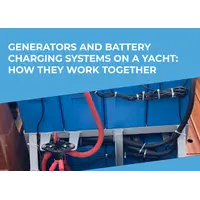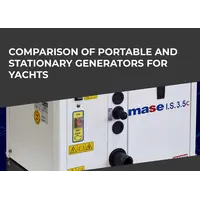Using their own experience with the SimpleSail charter fleet, which includes yachts of various types and modifications, topRik experts talk about how to prepare for the purchase of a new or used yacht for charter: what documents to prepare, what equipment to check, how to determine the general condition of the yacht and its suitability for charter use.

Choosing the ideal yacht for charter is influenced by many factors, including budget, owner's lifestyle and operating goals. Below we will focus on key recommendations, neglect of which can turn the purchase of a charter yacht into a headache for the owner.
By the way, if you are an experienced yachtsman, then you already know that the only ideal yacht is your own. But even experienced people sometimes need to be reminded that what you take for granted by default does not always correspond to reality. Especially when it comes to buying a boat that has already been in operation. And if you are buying a yacht for subsequent rental (either new or used), you should take into account that it may not be in such capable hands as yours, so any defect missed at the purchase stage can turn into a bunch of problems later.
Don’t Rely on Verbal Agreements
Any purchase agreement must be accompanied by a written contract. This way the boat can’t go to another buyer. To avoid other surprises when buying a boat, it is advisable to use a standard purchase and sale agreement that would be understandable to all parties and recognized by established practitioners. You can take the standard contract developed by Mediterranean Yacht Brokers Association (MYBA) as a sample. It balances and commits to the essential conditions: the purchase price of the boat, the amount of the deposit and the conditions for its return, the date of transaction completion, the place of the boat delivery, the consequences of unsatisfactory technical inspection of the boat, etc.
Inventory
When inspecting a boat, always make an inventory of items and equipment that is on board the yacht -the inventory list - it must be passed along with the vessel itself. We recommend that the inventory be drawn up as an integral written annex to the contract signed by the seller and the buyer.
Deal with Deposits in a Correct Way
The industry standard is a deposit of 10% of the purchase price of the boat, which is paid by the buyer either immediately or within a few days of signing the sales contract. For example, in accordance with the MYBA agreement, the deposit is paid to the account of a third party - the stakeholder, where it is stored until the transaction is completed. If certain conditions are met, for example, the seller does not deliver the boat, the deposit is returned to the buyer.
Check the Seller
When buying a boat, you must make sure that the seller is the actual owner, has the right to sell it, and there are no encumbrances on the yacht. To do this, check out the documents confirming the seller's ownership: construction certificate (builder's certificate) and previous bills of sale. The seller's ownership of the boat and the absence of encumbrances can be verified by requesting the appropriate extraction from the flag registry. We also recommend asking the seller for proof of payment for marina parking, a current insurance policy, and recent invoices for boat repairs.
If we are talking about buying a new yacht, then we should take into account that putting the yacht into operation with further transfer to the owner, especially if the owner is a beginner, will usually take more time than for experienced yachtsmen. This is because different shipyards have different approaches to the process of commissioning a yacht. Some shipyards do all the necessary work themselves, but many outsource part of the process to third parties. The third party may be your local dealer.
Many dealers inspect the yacht themselves for a period of time before handing it over to the owner. This check usually takes about a week. After this, the boat is tested for many days on land and at sea with the participation of the owner, who during this period can check all systems, structures, equipment, sailing equipment, controls, engines, etc. with advice from accompanying representatives of the shipyard or dealer.

Registration and Insurance
When carrying out reflation (exclusion from the current register and registration in a new one), the new owner will need a deletion certificate, the preparation of which is the responsibility of the seller.
Another important point is to take out new insurance coverage for the boat, the type of which depends on the type of boat, area of operation, etc. Be sure to check that the insurance covers the value of the yacht (including its contents) and third party liability.
Guarantees
Most shipyards provide a one-year warranty to the owner. But some parts of the structure have a longer warranty, such as the hull.
The warranty periods for equipment and devices are set out in the warranty documentation for these devices, which should be given to you upon delivery of the yacht.
It is in your best interest to study in detail the warranty conditions and obligations of the company from which you are buying a yacht.
Technical Inspection
When negotiating with the seller, be sure to emphasize that the boat will only be purchased subject to a satisfactory technical inspection and sea trials. If we are talking about a used boat, for such an inspection you cannot do without a qualified surveyor who can identify significant defects that affect the final price of the boat.
The price of such a service is usually around 500 euros - not cheap, but besides the fact that your future boat is looked at by an experienced person, you are also given a paper where, in addition to a list of problems, the estimated cost of the yacht is specified. The document will then be accepted by insurance companies and can be useful in the event of insured events, resale, re-registration, etc.
Exterior and Interior
Insufficient attention to the technical nuances of the yacht can significantly spoil the mood after purchasing the vessel, so pay attention to the exterior and interior of the yacht. To do this, ask the seller for the opportunity to inspect the underwater part of the hull. When buying a new boat, this is not a problem - manufacturers and dealers provide this opportunity at their own expense. But when buying a used boat directly from the owner, you may need to pay for the services of a crane operator.

Find out from the seller whether the boat is painted or has original gelcoat. Preference is given to an unpainted boat, even if a painted one looks nicer. If the boat is painted, this is a big con; most likely, traces of repairs are hidden - putty or more serious.
Sometimes traces of repair can be seen visually by looking at the bottom of the hull in a certain way, as if glancing at the surface. You can tap the body with a wooden handle of a screwdriver or an awl to identify the difference in sound: a dull sound may indicate internal voids in the plastic that appear during the process of osmosis.
In addition to the gelcoat, carefully check the condition of the windows and inspect the boat at its widest part. It would be a good idea to open everything that can be opened (cabinets, floorboards) and inspect all internal surfaces for mold, dirt and smudges.
There should be no cracks at the junction of the cabin and the deck. If there is teak or other floor covering on the deck, there should be no visible signs of peeling.
Portholes should be transparent, not mesh-like. The bow hatch should be equipped with a soft-touch pad.
The sealant where the stay cables enter the deck should not have cracks.
Make sure the locking doors close tightly and the locks work properly if you don't want pots and cans flying around the boat in stormy weather.
Engine
During the technical inspection, check the operation of the engine in different modes, because its further replacement means significant unplanned expenses in the future.
Diesel engines Perkins, Yanmar, Volvo Penta, Caterpillar, Vetus are an excellent option, since it is more difficult to find spare parts for others in some ports. So, check to see if the engines currently in production are the same brand as the one in the used boat you're looking at.
When starting the engine (on the water!) there may be a small bluish-colored exhaust from the exhaust pipe, but not white or black. Cooling water should flow immediately, the system should take in water at idle, and the oil pressure and battery charging alarms should be gone.
After a minute of engine operation there should be no smoke, the exhaust should not smell of diesel fuel or oil. After five minutes of engine operation, ask the seller to increase the throttle. If you place your hand in the exhaust, it should not become covered with oil or soot, and the water should be slightly warm to the touch, and no rainbow film or soot stains should appear on it.
After turning off the engine, we check the oil with a dipstick - it may be a little dark, but not thickened or, moreover, with lumps. If it turns out that the oil is completely fresh, changed right before the inspection, this may raise doubts.
Inspect the condition of the antifreeze by opening the cooling system cover. Antifreeze should be blue or greenish and clear, not brown and cloudy.
Next, verify that there are no oil or diesel leaks from the engine. The connecting tubes must be free of breaks and the clamps must be free of rust.
We start the hot engine with a half turn, drive it at different speeds, disconnecting it from the transmission. The engine sound should be smooth, without clanging or knocking.
You your hands to check the softness and ease of engaging gear and reverse. The sound of the motor should not change when switching, the vibration from the rotating propeller should be barely noticeable.
Yacht Management
To check the handling of the yacht, its propulsion, the ease of operation of the helm and to make sure that there is no play at the rudder, we recommend that you test the yacht at sea. For a sailing yacht, it is important to check the condition of the standing and running rigging. When it comes to the underwater part, it is necessary to inspect the anodic protection of the hull.
Systems and Equipment
Before agreeing to purchase, you should definitely check the water system - open and close all the taps, check the seawater pump, fuel and gas systems – make sure that everything works properly and meets safety issues. If you do not consider yourself an expert, you should invite a specialist to check electrical equipment, circuits, and navigation devices.
Spar and Rigging
During the survey inspection, check the appearance and operation of winches and stoppers; examine in detail whether the mast was previously bent or broken, check the fixation of the shrouds and stays (for the rust stains and deformations in the stowage areas). Pay attention to whether the rivets on the mast are loose, check the rails, stays and other equipment.








